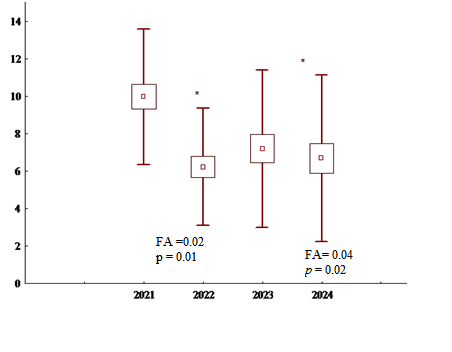EFFECT OF LOW NIGHT AIR TEMPERATURE ON FLUCTUATING ASYMMETRY OF BIRD CHERRY LEAF BLADES
EFFECT OF LOW NIGHT AIR TEMPERATURE ON FLUCTUATING ASYMMETRY OF BIRD CHERRY LEAF BLADES
Abstract
The effect of night and day temperatures on the asymmetry of the leaf blades of the common bird cherry (Prunus padus L.) was studied. Temperature fluctuations in May 2021-2024 in Elektrostal (Moscow region) were studied. A statistically significant difference in May night temperatures was obtained. The difference in temperature between day and night did not show a deviation in asymmetry. Low temperatures were observed in 2022 and 2024 (-1°C). In these years, statistically significant indices of fluctuating asymmetry were obtained. In 2022 – FA = 0,002 and in 2024 – FA = 0,004 (respectively, p = 0,01 and p = 0,02). The work shows a significant effect of late spring frosts on the morphological features of the leaf blades of Prunus padus, indicating a decrease in the stability of the development of this species.
1. Introduction
The foliation process in a tree is influenced by temperature, illumination, atmospheric CO2 level, and air humidity. These factors affect the rate of transpiration. According to the Global Carbon Budget at COP29/, global greenhouse gas emissions could be 2,5% higher in 2024 than in 2023, contributing to a significant increase in atmospheric temperatures. An early start to the growing season is known to result in plant damage in the event of spring frosts. An early spring in Central and Northern Europe in 2018 contributed to increased vegetation growth and increased summer drought. The night temperature fluctuations cause inhibition of growth of both stems and leaf blades and affect the formation of their morphological structures. It is known that positive night temperatures stimulate the consumption of nutrients for respiration and promote metabolism, increasing the biomass of leaf blade tissue. Low (even negative) temperatures at night lead to weakening of respiration, and often to damage the leaves of many woody plants.
The fluctuating asymmetry (FA) is a minor fluctuation in the difference in the values of bilaterally symmetrical structures, including metric features. FA is considered an indicator of developmental instability. According to Valkam Ya. and Kozlov M.V. (2001), the coldest summer periods of 1993-2000 on the Kola Peninsula caused a decrease in the developmental stability of mountain birch (Betula pubescens subsp. czerepanovii (N.I. Orlova, Hamet-Ahti), while the temperature factor was no less significant than the anthropogenic pollution factor
.Bird cherry (Prunus padus L.) is not the most valid bioindicator of anthropogenic pollution of the environment compared to other tree species; its use requires improvement of the methodology for assessing the stability of development using FA indices
, . Two-factor analysis of variance, taking into account the distribution of the values of the right and left bilateral features of the leaf blades of this species, gives the most verified results .The previous studies show that in northern populations of the Kola Peninsula, the shape of the bird cherry leaf blades varies to a greater extent than their asymmetry. Moreover, northern populations did not show increased fluctuating asymmetry
, . A related species, Maak's bird cherry, had even less fluctuating asymmetry compared to common bird cherry . The late spring frosts are typical for May, the last month of spring when bird cherry leaves. The objective of our study was to determine the effect of air temperature in May on the asymmetry of common bird cherry folietes.2. Research methods and principles
We used digitized herbarium collected in 2021-2024 in Elektrostal, Moscow Region. Ten leaves from five trees of approximately the same age but with different leaf blade sizes were examined. The width of the left and the right halves of each leaf blade was measured three times using a TPSDIG2 digitizer. The day and night temperatures in May were obtained from the GOSMETEO archive. To determine temperature variations, the difference between day and night date (average daily air temperature) was found and the variation coefficient of these values was determined.
The fluctuating asymmetry was found in a two-factor ANOVA for the significance of the interaction of the factors "leaf × side". The FA10 index was obtained for each population, the probability level p was adjusted using the Bonferroni method, i.e. the least significant index was assigned the level p = 0,05. Directional asymmetry was tested by the null hypothesis H0: L = R in a two-factor ANOVA for the significance of the factor "side". The normality of the samples was tested by the Shapiro-Wilk test using an online calculator. The significance level in the methods of probability statistics was α = 0,95.
3. Main results
The test for normality of temperature data distribution did not reveal any deviations (Shapiro test p> 0,05).
The greatest width of leaf blades was noted in 2023 and 2024. The directional asymmetry was present in leaf collections of 2022 and 2023 with a high significance of the "side" factor (p<<0,05).
Allometric correlation between the value of the trait and FA was not carried out. A statistically significant difference was obtained for May night temperatures in the period 2021-2024. The lowest average monthly temperature in May was noted in 2022 (6,2°C) and 2024 (6,7°C) (Fig. 1).

Figure 1 - Results of one-way ANOVA
Note: nighttime temperature values (OY axis) were statistically different in May 2021-2024 (p = 0,001). Leaves collected in 2022 and 2024 showed a significant FA index (highlighted with an asterisk)
4. Conclusion
The climate change on Earth is leading to higher night temperatures in some regions, such as tropical forests. Thermomorphogenesis of plants is associated with increased respiration at night
, . Climate change modeling shows stronger warming in northern high latitudes than in the south . We considered, how the spring temperature fluctuations with night frosts in central Russia slow down the respiration process, reducing the stability of development of tree species, including Prunus padus.We classify the past frosts as the radiation frosts, typical for nighttime, which appear as a result of the passage of an anticyclone from the north. As a result, there was a strong supercooling of the soil's surface. Such weather anomalies were caused by the movement of cold masses due to the unusual movement of cyclones: to the west and to the east of Moscow. This contributed to the drawing in of cold air from the territories of the Far North.
Similar frosts recorded in Germany in 2011 showed a high percentage of damage to deciduous trees against the background of a shift in phenological dates to earlier dates in the context of global warming .
According to Hufkens K. et al., post-leaf frosts will become more common with climate change and may affect both the composition of European forests and ecosystem productivity . The studied phenomenon deserves attention from the point of view of developmental stability, due to a weak understanding of the factors that deviate homeostasis from the normal developmental trajectory. The genetic variability of plants is predicted to increase with further climate warming. We believe that long-term studies of two types of asymmetry (directional and fluctuating) are a serious tool for determining plant responses to the climate of global warming.
